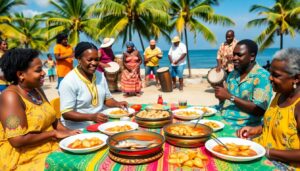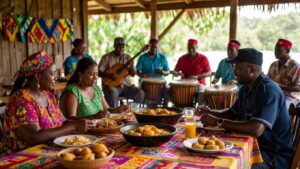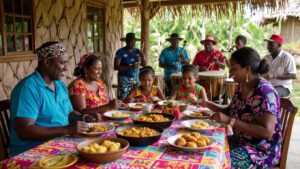Unveiling the Vibrant Garifuna Culture in Belize: A Journey Through Heritage, Gastronomy, and Cultural Experiences
The Garifuna community of Belize embodies a rich tapestry woven from African, Indigenous Caribbean, and European cultural threads, resulting in a distinctive heritage that is both globally celebrated and officially recognised by UNESCO. Their traditions reflect a wide array of cultural elements, including language, music, culinary arts, dance, and a profound sense of spirituality and community. This comprehensive guide takes you on an enlightening journey through the fascinating story of the Garifuna in Belize, highlighting their history, traditions, vibrant festivals, delectable cuisine, and the culturally rich hub of Hopkins Village.
Diving Deep into the Garifuna Heritage
The Garifuna people are recognised as one of the most unique cultural groups in Belize, with ancestral roots tracing back to West and Central African forebears, alongside the Indigenous Caribs and Arawaks. After their resistance to colonial oppression in St. Vincent in 1797, they were forcibly relocated to Central America. Presently, the Garifuna population in Belize is around 30,000, playing a vital role in the cultural mosaic of southern Belize through their unique language, exquisite cuisine, dynamic art, and rich customs. UNESCO has recognised them as a Masterpiece of the Oral and Intangible Heritage of Humanity, and their spirit, creativity, and adaptability thrive in communities such as Dangriga, Hopkins, Seine Bight, and Punta Gorda, as well as in diaspora communities across the Americas. The celebration of Garifuna Settlement Day on November 19th is a testament to their resilience, unity, and rich cultural heritage.

Unearthing the Historical Roots of the Garifuna Community
Tracing the Ancestral Lineage: African and Carib Heritage
The story of the Garifuna community dates back to the 17th century, marked by the extraordinary union of African survivors from two Spanish slave ships and the Indigenous Carib and Arawak inhabitants of St. Vincent in the Lesser Antilles. Over the course of more than 150 years, intermarriage and cultural exchange fostered a distinctive Afro-Indigenous identity known as the Garinagu. This identity is characterised by a rich blend of traditions, languages, and practices that echo their diverse ancestral backgrounds and create a unique cultural narrative.
Forced Exile and the New Beginnings in Belize
In 1797, following fierce resistance to British colonial powers, around 5,000 Garifuna individuals were forcibly exiled from St. Vincent to Roatán, Honduras. This marked the beginning of their migration along the Central American coast. By the early 19th century, vibrant Garifuna communities flourished in southern Belize, particularly in culturally significant areas such as Dangriga, which is often referred to as the cultural capital, along with Hopkins, Seine Bight, and Barranco. The British authorities supported these migrations, seeking skilled labourers proficient in fishing and agriculture, which facilitated the establishment and growth of these communities.
Endurance and Cultural Continuity Amidst Challenges
Despite the numerous adversities posed by European colonisation, land dispossession, and systemic discrimination, the Garifuna have effectively maintained their language, social structures, and rich spiritual traditions. The establishment of the National Garifuna Council in 1981 has played a pivotal role in advocating for their cultural rights and education, ensuring that the heritage of the Garifuna continues to be acknowledged and celebrated.
The Importance of Language and Identity in Garifuna Culture
The Distinctive Nature of the Garifuna Language
The Garifuna language is an Arawakan language that stands out due to its incorporation of Carib and African loanwords, rendering it a remarkable example among languages in Central America. This language showcases gendered pronouns, a complex tense system, and a wealth of oral traditions that encapsulate the community's history and cultural values. Nonetheless, the survival of the Garifuna language faces threats from language shift due to migration and urbanisation, with fewer than 15,000 Belizean Garifuna individuals remaining fully fluent in their mother tongue.
Initiatives for Revitalisation and Preservation of the Language
The recognition of the Garifuna language and music as an Intangible Heritage by UNESCO in 2001 has sparked significant revitalisation efforts. In communities such as Hopkins and Dangriga, primary schools now provide educational programmes in Garifuna, while community radio stations broadcast music and news in the language, contributing to its preservation. Organisations like GAMAE International have initiated language immersion summer camps aimed at reconnecting youth with their ancestral roots and linguistic heritage, fostering a sense of identity and belonging.
Expressions of Identity and Global Diaspora Connections
The Garifuna identity is reinforced through traditional clothing, ancestral lineage, clan totems, and unique naming conventions. This identity is actively nurtured by cultural associations both within Belize and in diaspora communities located in major cities such as New York, Los Angeles, and London, where they continue to honour and celebrate their rich heritage.
The Dynamic Realm of Garifuna Music and Dance
The Spiritual and Rhythmic Essence of Garifuna Music
Garifuna music is renowned for its intricate rhythmic structures, which harmoniously blend traditional African polyrhythms with indigenous chants. Drums—specifically the primero (tenor) and segunda (bass)—are central to many spiritual rituals and festive events. The sacred dugú ceremony, for example, incorporates drum circles and ancestral invocations aimed at healing or blessing families, showcasing the profound connection between music and spirituality in Garifuna culture.
Celebrating Life Through Punta and Punta Rock Dance Styles
One of the most celebrated dance forms within Garifuna culture is the punta, which features rapid hip movements and intricate footwork, often accompanied by call-and-response singing and vibrant percussion. The contemporary evolution of this dance style, known as punta rock, has gained popularity through prominent musicians such as Andy Palacio and Pen Cayetano, who blend traditional rhythms with modern instrumentation, thus helping to spread Garifuna culture to a global audience.
Cultural Festivals and Community Celebrations in Garifuna Life
In the lively towns of Hopkins and Dangriga, dance troupes frequently perform during cultural festivals and for visiting tourists, creating a vibrant link between generations. These performances not only celebrate Garifuna heritage but also serve as a significant economic resource for the community, promoting tourism and cultural exchange while allowing the younger generation to engage with their roots.

Examining Garifuna Cultural Practices and Spiritual Beliefs
The Deep Meaning of the Dugú Ceremony
The dugú ceremony is a multi-day gathering where extended families unite to honour the spirits of their ancestors, referred to as gubida. Guided by a spiritual healer, or buyei, the ceremony encompasses music, dance, and communal feasting, all aimed at restoring harmony within families and the wider community. It underscores a deep respect for the land, ancestral heritage, and shared responsibilities among community members.
Daily Life and Spiritual Beliefs of the Garifuna People
The spiritual beliefs of the Garifuna represent a unique blend of Catholicism intertwined with African and Arawak cosmologies. Their daily life is enriched by various rituals, which include blessings for new buildings, rites of passage for births and deaths, and celebrations linked to agriculture. Important symbols such as the conch shell, sea turtle, and cassava serve as vital links between households, the natural world, and the spirits of their ancestors, reinforcing their cultural identity.
Exploring the Rich Flavours of Garifuna Cuisine
Signature Dishes and Culinary Staples
The culinary landscape of Garifuna culture is deeply embedded in staples such as cassava (or yuca), plantains, coconut, and fresh seafood. Among traditional offerings, ereba stands out as a unique cassava bread, meticulously prepared by grating cassava, pressing it, and toasting it over an open flame. Another signature dish, hudut, showcases fish cooked in creamy coconut milk and is typically served alongside mashed green and ripe plantains. Other popular dishes include machuca, a hearty fish soup enriched with garlicky mashed plantain dumplings, and tapou, a savoury seafood stew made with coconut milk. In bustling street markets in Hopkins and Dangriga, visitors can indulge in local delights such as cassava pone (a sweet cake), fried plantain balls (known as ganún), and refreshing conch ceviche, which highlight the rich culinary traditions of the Garifuna.
Championing Sustainable Culinary Practices
Traditional Garifuna practices such as seasonal fishing, shellfish gathering, and small-scale gardening promote ecological stewardship and sustainability. These practices are informed by cultural taboos and principles of communal resource management. Culinary festivals held in Hopkins feature cooking competitions and food tours organised by women’s cooperatives, ensuring the preservation of traditional recipes and culinary techniques while engaging visitors in the vibrant gastronomic heritage of the Garifuna.
Hopkins Village: The Heartbeat of Garifuna Culture
Historical Context and Cultural Significance of Hopkins
Established in the early 1800s and referred to as Yarumein in Garifuna, Hopkins is beautifully situated along the scenic Stann Creek coast. This village serves as a central hub for the Garifuna language, music, and crafts, fully embodying the rich cultural legacy of the community and providing a gateway for cultural immersion.
Unmissable Experiences in Hopkins Village
- Drum Circles: Engage in daily drum schools and enjoy nightly drum circles at local cultural centres, connecting with the rhythm of Garifuna life.
- Garifuna Museum: Discover artefacts, oral histories, and photographic records that explore the themes of migration, language, and music within Garifuna culture.
- Homestays and Workshops: Immerse yourself in local life by engaging with families who offer cooking lessons, fishing trips, and demonstrations of cassava bread making, enriching your experience.
Annual cultural events in Hopkins, particularly the youth pageants held during Garifuna Settlement Day, position the village as an authentic gateway to experiencing the vibrant cultural tapestry of Garifuna Belize.
Economic Impact of Cultural Tourism on the Community
Cultural tourism plays a crucial role in the economy of Hopkins, supporting over 75% of local households through accommodations, handicrafts, music classes, and guided tours. The National Garifuna Council serves as the headquarters for coordinating regional festivals and advocacy efforts, ensuring that Garifuna culture remains dynamic and visible to both locals and visitors.
Commemorating Garifuna Settlement Day: A Celebration of Culture
Historical Importance of Settlement Day
Celebrated each November 19 since 1941 and nationally recognised since 1977, Garifuna Settlement Day commemorates the momentous arrival of Garifuna ancestors in Belize by canoe in 1802. The reenactment procession, known as Yurumein, sees villagers arriving ashore with drums, cassava, and crops amidst joyous singing and prayers, symbolising their enduring legacy and cultural continuity.
Contemporary Celebrations and Festivities
The festivities of Garifuna Settlement Day beautifully blend sacred and secular elements, featuring nightlong dugú ceremonies and all-day drumming in churches and community squares. Processions adorned in traditional attire, lively parades, dance performances, and food fairs characterise the day. National broadcasts, media coverage, and diaspora celebrations in major US cities attract visitors from across Belize and beyond, fostering greater awareness and appreciation for Garifuna cultural traditions.
Addressing Modern Challenges and Sustaining Cultural Heritage
The Language Shift and Its Impact on Youth
The phenomenon of language shift poses a significant threat to the Garifuna community, with many young people, particularly those in urban areas, increasingly opting to speak English or Kriol at home. UNESCO has recognised this alarming trend, leading schools and NGOs to implement immersive language programmes, radio broadcasts, and mentorship initiatives aimed at preserving the linguistic heritage and cultural identity of the Garifuna.
Land Rights Issues and Tourism Development Pressures
The rapid growth of tourism and real estate development in coastal regions such as Seine Bight and Hopkins endangers the traditional landholdings of the Garifuna. Advocacy efforts from the National Garifuna Council and collaborative NGOs focus on securing land rights, influencing urban planning, and ensuring that the economic benefits of tourism are shared with local families and communities, thus promoting sustainable development.
Engaging the Youth through Arts, Technology, and Diaspora Connections
Garifuna artists and musicians, both within Belize and in the diaspora, are actively documenting music, preserving recipes, and recording oral histories to create digital archives and virtual festivals. These modern platforms play a pivotal role in fostering connections between the wider Garifuna community and younger generations, ensuring that their rich cultural heritage is celebrated and maintained for future generations.
Guidelines for Respectfully Experiencing Garifuna Culture
- Select accommodations in Hopkins, Dangriga, or Seine Bight, and book tours directly with Garifuna-owned businesses to support the local economy.
- Engage in a drum workshop, attend a Settlement Day celebration, or volunteer in local cultural preservation initiatives to immerse yourself in this vibrant culture.
- Support women’s cooperatives by sampling traditional dishes or purchasing handcrafted items to promote sustainable livelihoods within the community.
- Always show respect for local customs; seek permission before photographing individuals and remain mindful during rituals and ceremonies.
- Learn a few basic phrases in the Garifuna language to express your respect and genuine interest in the culture.
The Garifuna culture in Belize embodies a vibrant tapestry of resilience, deep spirituality, infectious music, delectable culinary offerings, and strong community bonds. By visiting places like Hopkins or Dangriga, participating in local festivals, or immersing oneself in the rhythmic heartbeat of the drums, travellers are granted a unique opportunity to engage with a rich historical continuum where the past and present resonate together. Supporting businesses owned by the Garifuna, honouring their traditions, and celebrating the linguistic and culinary diversity of this remarkable culture are essential steps to ensure its survival and flourishing for future generations.
References and Further Reading on Garifuna Culture
- Language, Dance and Music of the Garifuna – UNESCO Intangible Heritage
- History Of The Garifuna People – Belize.com
- Garifuna people – Wikipedia
- Varner, G.R. “Native Status and Maya Identity in Belize.” Journal of Latin American Anthropology, 1998
- Lee, N.R. “Toledo Garifuna and Indigenous Rights.” Mesoamerican Research, 2022
- National Garifuna Council – Wikipedia
- The Garifuna Living Heritage – ICH NGO Forum, 2023
- Dinther, R. “Language Shift and Prestige: Garifuna in Hopkins.” Journal of Pidgin and Creole Languages, 2017
- Habinaha Garifuna Language Program
- Veal, T. “Africanisms in Garifuna Culture of Belize.” Cultural Anthropology, 2004
- National Geographic: Preserving Garifuna Identity Through Ritual
- Music In Africa: Punta Rock and Garifuna Music
- Hopkins Cultural Center Official Site
- Cultural Survival Quarterly: Maya Rainforest and Garifuna in Belize
- Belize Living Heritage: Rituals and Social Practices
- Texas A&M: Belizean Food Culture
- Love Your Belize: Hudut Recipe
- Global M&A Pages: Sustainable Fishing Cooperatives
- National Garifuna Council of Belize
- UN Sustainable Development Reports on Garifuna Cultural Tourism
- Ambergris Caye: Garifuna Settlement Day Celebrations
- Garifuna.com: Diaspora, Digital Storytelling, and Modern Initiatives
The Article Garifuna Culture in Belize: Heritage, Food & Where to Experience It appeared first on Belize Travel Guide
The Article Garifuna Culture: Experience Heritage and Cuisine in Belize Was Found On https://limitsofstrategy.com


